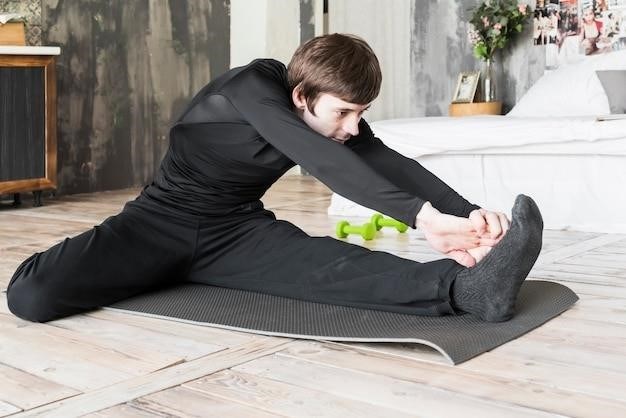iliotibial band syndrome stretches pdf
What is Iliotibial Band Syndrome (ITBS)?
Iliotibial band syndrome (ITBS) is a common overuse injury that affects the iliotibial band, a thick band of tissue that runs along the outside of the thigh from the hip to the knee. ITBS causes pain and tenderness on the outside of the knee, especially during or after exercise. It is often seen in runners, cyclists, and other athletes who engage in repetitive movements.
What is the IT Band?
The iliotibial (IT) band is a thick band of fascia that runs deep along the outside of your hip and extends to your outer knee and shinbone. It plays a crucial role in stabilizing the knee joint and helping with hip and knee movement. The IT band is made up of dense connective tissue, which gives it its strength and durability. However, this same density can make it prone to inflammation and pain, particularly when it is subjected to repetitive stress or overuse, as in running or cycling.
Causes of ITBS
ITBS is often caused by overuse and repetitive movements, which can lead to friction and inflammation of the IT band. Other factors that can contribute to ITBS include⁚ poor biomechanics, such as tight hip flexors or weak gluteal muscles, sudden increases in training intensity or mileage, inadequate warm-up and cool-down routines, improper footwear, and running on uneven surfaces. If you experience pain on the outside of your knee, especially during or after exercise, it is important to consult with a healthcare professional to determine the cause of your pain and receive appropriate treatment.

IT Band Stretches⁚ Why They Don’t Work
While IT band stretches are often recommended for ITBS, they are not actually effective at stretching the IT band itself. The IT band is a thick, fibrous structure that is not easily stretched.
The IT Band Can’t Be Stretched
The IT band is not a muscle, but a thick band of fascia, which is a type of connective tissue. Fascia is not as elastic as muscle tissue and does not respond to stretching in the same way. Stretching the IT band directly is not possible because it’s tightly connected to the surrounding muscles and does not have the ability to lengthen significantly. Instead of trying to stretch the IT band, focus on stretching the muscles that attach to it, particularly the hip flexors and the tensor fascia latae. This will help to improve flexibility and reduce tightness around the IT band.
What to Stretch Instead
Instead of focusing on directly stretching the IT band, which is not possible, it’s more effective to target the muscles that attach to it. These include the hip flexors, tensor fascia latae, and the muscles in the back of the thigh (hamstrings). Stretching these muscles can help improve flexibility and reduce tightness around the IT band, which in turn can help alleviate ITBS symptoms. Common stretches for these muscles include the standing quad stretch, the pigeon pose, and the hamstring stretch. These stretches should be held for at least 30 seconds and repeated multiple times throughout the day.
IT Band Syndrome Rehabilitation Exercises
Rehabilitation exercises for ITBS focus on improving flexibility, strength, and range of motion. These exercises can help reduce pain, improve function, and prevent future injuries.
Iliotibial Band Stretch (Standing)
To perform a standing IT band stretch, cross your uninjured leg in front of your injured leg and bend down and touch your toes. Hold this position for 15-30 seconds, and repeat 3-5 times. This stretch helps to lengthen the IT band and improve flexibility in the hip and knee.
Iliotibial Band Stretch (Side-Leaning)
Stand sideways to a wall, your injured leg toward the inside. Place the hand nearest the wall on the wall for support. Cross the leg farthest from the wall over the other leg, keeping the foot closest to the wall flat on the floor. Lean your hips into the wall. Hold the stretch for 15 seconds, repeat 3 times, and then switch legs and repeat the exercise another 3 times.
Standing Calf Stretch
Stand facing a wall or sturdy object, about an arm’s length away. Place your hands on the wall for support. Step back with one leg, keeping the other leg straight. Lean forward, keeping your back straight and your heel on the ground. You should feel the stretch in your calf muscle. Hold the stretch for 30 seconds, repeat 3 times, and then switch legs and repeat the exercise another 3 times.

Strengthening Exercises for ITBS
Strengthening the muscles around your hips and knees can help to prevent ITBS and reduce pain.
Hip Abductor Exercises
Hip abductor exercises strengthen the muscles that help to stabilize your hip and prevent inward rotation of your leg. These exercises are important for ITBS because they help to reduce the strain on the IT band and improve the mechanics of your gait. Here are a few examples of hip abductor exercises⁚
- Side-lying hip abduction⁚ Lie on your side with your top leg straight and your bottom leg bent. Slowly raise your top leg up towards the ceiling, keeping your leg straight. Lower your leg back down to the starting position. Repeat 10-15 times.
- Standing hip abduction⁚ Stand with your feet hip-width apart and hold a light weight in each hand. Slowly raise one leg out to the side, keeping your leg straight. Lower your leg back down to the starting position. Repeat 10-15 times on each side.
These exercises can be done with or without weights, depending on your fitness level. Be sure to start slowly and gradually increase the number of repetitions and sets as you get stronger.
Gluteus Medius Strengthening
Strengthening the gluteus medius muscle is crucial for ITBS rehabilitation. This muscle plays a vital role in stabilizing the hip and controlling outward rotation of the leg during movement. Weak gluteus medius muscles can lead to increased stress on the IT band, contributing to pain and inflammation.
Here are a few examples of gluteus medius strengthening exercises⁚
- Side-lying hip abduction with resistance band⁚ Lie on your side with a resistance band around your thighs. Slowly raise your top leg up towards the ceiling, keeping your leg straight and resisting the band. Lower your leg back down to the starting position. Repeat 10-15 times;
- Standing hip abduction with resistance band⁚ Stand with your feet hip-width apart and a resistance band around your thighs. Slowly raise one leg out to the side, keeping your leg straight and resisting the band. Lower your leg back down to the starting position. Repeat 10-15 times on each side.
Remember to choose a resistance band that provides a challenging but manageable level of resistance for your strength;
Preventing ITBS
Preventing ITBS involves a combination of proper training techniques, adequate stretching, and a focus on warming up and cooling down effectively.
Proper Training Techniques
Proper training techniques are crucial to preventing ITBS. Gradually increasing your training volume and intensity, ensuring proper shoe fit, and using appropriate running surfaces can minimize stress on your IT band. Additionally, incorporating cross-training activities into your routine can help prevent overuse injuries by providing variety and reducing repetitive strain.
Stretching, Warm-up, and Cool-down
Adequate stretching, warm-up, and cool-down routines are essential for preventing ITBS. Before exercise, dynamic stretches that activate the muscles surrounding the hip and knee, such as leg swings and lunges, should be performed. After exercise, static stretches targeting the IT band and surrounding muscles, such as the standing IT band stretch or the side-leaning IT band stretch, can help improve flexibility and reduce muscle tightness.
IT Band Syndrome⁚ A Common Cause of Knee Pain
ITBS is a common cause of knee pain, particularly in runners and cyclists, due to repetitive movements that strain the IT band.
ITBS in Runners
Runners are particularly susceptible to ITBS due to the repetitive motion of their legs and the impact forces they experience. The IT band rubs against the bony prominence on the outside of the knee (lateral epicondyle) with each stride, leading to inflammation and pain. This can worsen with distance, terrain, or improper running form. If you’re a runner experiencing pain on the outside of your knee, ITBS could be the culprit.
ITBS in Cyclists
Cyclists are also prone to ITBS due to the repetitive motion of pedaling. The constant pressure on the outside of the knee, especially when riding for long periods or on hilly terrain, can irritate the IT band. A bike seat that’s too high or too low can exacerbate the problem by altering leg positioning and increasing stress on the IT band. If you’re a cyclist experiencing pain on the outside of your knee, consider adjusting your bike setup and incorporating stretches into your routine.
Resources for IT Band Syndrome
For further information and support for IT band syndrome, consider consulting these resources⁚
UCSF Sports Medicine Rehabilitation Resources Guide
The UCSF Sports Medicine Rehabilitation Resources Guide offers a valuable resource for patients seeking guidance on at-home exercises. This comprehensive guide provides instructional videos and downloadable PDF instructions for various exercises, ensuring patients can effectively follow their provider’s prescriptions. The guide covers a range of exercises, including those specifically designed for IT band syndrome, ensuring individuals can find the appropriate exercises for their condition and recovery needs.
Orthopaedics Rehabilitation Resources
Orthopaedics Rehabilitation Resources offer comprehensive guidance for individuals seeking support and information regarding IT band syndrome rehabilitation. These resources provide access to a wealth of information, including exercises specifically designed to address IT band syndrome and promote recovery. Whether seeking guidance on specific exercises or general information on IT band syndrome management, these resources provide valuable support for individuals navigating their rehabilitation journey.
Mayo Clinic Appointments
Mayo Clinic, a renowned healthcare provider, offers appointments for individuals seeking medical expertise and treatment for IT band syndrome. With locations in Arizona, Florida, and Minnesota, Mayo Clinic provides a comprehensive approach to patient care, encompassing diagnosis, treatment planning, and rehabilitation. By scheduling an appointment, individuals can access the knowledge and resources of Mayo Clinic’s medical professionals, ensuring a personalized plan for managing and addressing their IT band syndrome.
Dartmouth Hitchcock Medical Center
Dartmouth Hitchcock Medical Center, a leading healthcare institution in northern New England, offers comprehensive services for patients with IT band syndrome. Their team of experienced healthcare professionals provides expert diagnosis, treatment, and rehabilitation for this common condition. By leveraging their expertise and advanced medical technologies, Dartmouth Hitchcock Medical Center aims to alleviate pain, restore function, and improve the overall well-being of individuals affected by IT band syndrome.
OrthoIndy
OrthoIndy, a renowned orthopedic care provider in Indianapolis and beyond, provides a comprehensive range of services for patients with IT band syndrome. Their team of highly skilled orthopedic surgeons, physical therapists, and other specialists offer personalized treatment plans tailored to individual needs. From diagnosis and treatment to rehabilitation and prevention, OrthoIndy’s commitment to patient care ensures optimal outcomes for individuals seeking relief from IT band pain and dysfunction.


